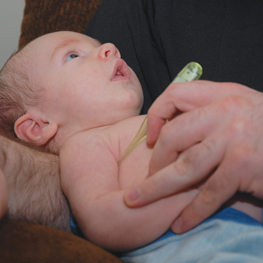
Children aren’t always able to tell you what’s wrong when they aren’t feeling well and might be sick. One sign that they might be sick is when their body temperature is higher or lower than normal - but what’s normal? When should you take your child’s temperature and how should you take it? A normal body temperature under your child’s armpit (axilla) is between 36.5°C to 37.5°C. When your child’s body is trying to fight off an illness or infection, their temperature can rise higher than 37.5°C. This is called a fever.
When to take your child’s temperature
Take your child’s temperature if they:
How to take your baby or child’s temperature under their arm
The easiest way to take your child’s temperature is under their armpit (axilla) by using an underarm digital thermometer.
Here’s how to take your child’s temperature:
Clean thermometer before use. Clean the thermometer by following the manufacturer’s instructions. If instructions are not available, clean the thermometer with warm, soapy water and rinse with cool water.
Wait after a bath. If your child just had a bath, wait at least 15 minutes.
Loosen clothes. Loosen your child’s clothes to the waist.
Place thermometer. Place the thermometer horizontally under their arm, so that the tip is in the centre of the armpit and the other end extends out front. Make sure your child’s arm is tucked snugly but gently against their body.
Wait for the beep. Leave the thermometer in place for about one minute, until you hear the beep.
Remove, read, record. Remove the thermometer and read the temperature. Write down the temperature and the time you took it so you can tell your health care providers if they ask.
Clean thermometer after use. Clean and dry the thermometer after use following the manufacturer’s instructions or with warm, soapy water and rinse with cool water.
If your child has a fever, talk to your pharmacist or health care provider before giving them any fever medicine.
If you have any questions or concerns about your child’s fever, call Health Link at 811 or talk with your health care provider.
Babies younger than six months: If your young baby has a fever, they need to be seen by a health care provider right away (within four to six hours) because they can become sick very quickly.
Babies six months old or older: If your older baby has a fever, they need be seen by a health care provider if their fever:
This information contains excerpts from Alberta Health Services’ Healthy Parents, Healthy Children print and online resources. For more information on fever and other topics related to pregnancy and being a parent, and for information on where you can pick up print copies of the Healthy Parents, Healthy Children resources, free of charge, go to healthyparentshealthychildren.ca.
The Healthy Parents, Healthy Children team is a part of the larger Healthy Children and Families’ team at Alberta Health Services. Find them on Facebook at Healthy Parents, Healthy Children or follow on Twitter @AHS_HPHC. For questions or comments, contact This email address is being protected from spambots. You need JavaScript enabled to view it..
Calgary’s Child Magazine © 2025 Calgary’s Child